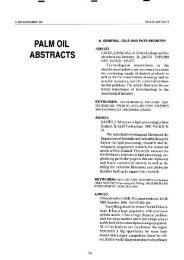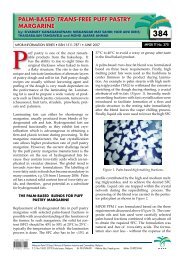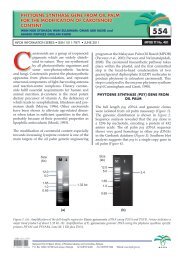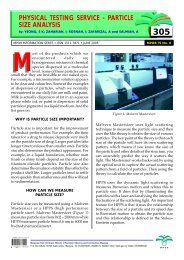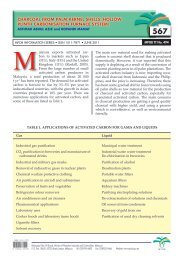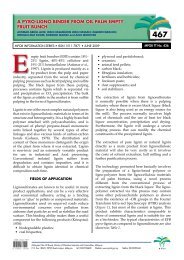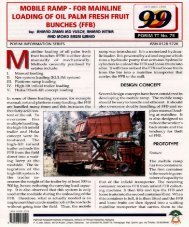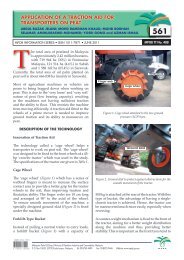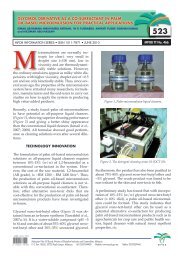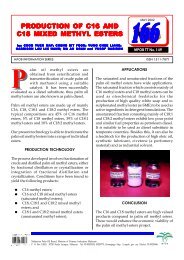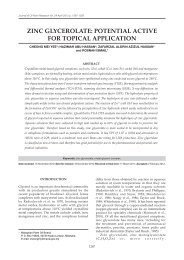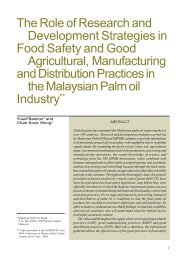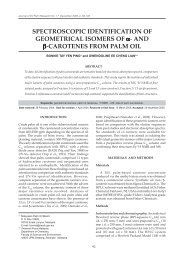indirect methods for measuring oil palm leaf area index - PALMOILIS ...
indirect methods for measuring oil palm leaf area index - PALMOILIS ...
indirect methods for measuring oil palm leaf area index - PALMOILIS ...
Create successful ePaper yourself
Turn your PDF publications into a flip-book with our unique Google optimized e-Paper software.
MAY 2002<br />
INDIRECT INDIRECT METHODS METHODS FOR<br />
FOR<br />
MEASURING MEASURING OIL OIL PALM<br />
PALM<br />
147 147 147 147 147<br />
LEAF LEAF AREA AREA INDEX INDEX (LAI) (LAI)<br />
by: MOHD ROSLAN MD NOOR; MOHD HANIFF HARUN; SITI NOR<br />
AISHAH MUSTAKIN; ABDULLAH BADRISHAH and MAURAD AHMAD MPOB TT No. 130<br />
MPOB INFORMATION SERIES ISSN 1511-7871<br />
ne of the important parameters in crop<br />
growth is <strong>leaf</strong> <strong>area</strong> <strong>index</strong> (LAI). It<br />
represents the <strong>leaf</strong>iness of the crop as<br />
measured by the ratio of <strong>leaf</strong> to ground<br />
surface <strong>area</strong>. This <strong>index</strong> is often used in<br />
Oof<br />
radiation conversion efficiency models,<br />
and in modelling photosynthetic response<br />
the canopy to incident light (Dufrene et al., 1993). The<br />
available LAI data would now be one of the more<br />
important parameters to be included in the GIS mapping<br />
<strong>for</strong> the precision agriculture. However, accurate direct<br />
measurement of LAI is laborious and time consuming.<br />
According to the conventional method, LAI of <strong>oil</strong> <strong>palm</strong> is<br />
determined by the following <strong>for</strong>mula:<br />
LAI = frond number per <strong>palm</strong> x <strong>leaf</strong> <strong>area</strong> per frond x<br />
planting density / 10 000<br />
where <strong>leaf</strong> <strong>area</strong> is based on vegetative measurements<br />
done on frond number 17.<br />
As an alternative, various <strong>methods</strong> of <strong>measuring</strong> foliage<br />
<strong>area</strong> and foliage angles have been developed to facilitate<br />
LAI measurements. The LAI-2000 Plant Canopy Analyser<br />
(Li-Cor Incorporated, Lincoln, NE USA) is one such<br />
instrument developed to measure LAI. It uses a fish-eye<br />
light sensor that measures diffuse radiation<br />
simultaneously in five distinct angular bands about the<br />
zenith point (Welles, 1990). The amount of foliage in a<br />
vegetation canopy can be deduced from measurements<br />
of how quickly radiation is attenuated as it passes through<br />
the canopy.<br />
MATERIALS AND METHODS<br />
Measurements of LAI using the LAI-2000 Plant Canopy<br />
Analyser are made by positioning the optical sensor and<br />
pressing a button. Both above and below canopy readings<br />
are needed. The data are automatically logged and after<br />
readings taken, the control unit per<strong>for</strong>ms all the<br />
calculations and the results are available <strong>for</strong> immediate<br />
on-site inspection. The LAI is computed using a radiative transfer model.<br />
The two different techniques used to determine the LAI are as follows:<br />
1. Measuring individual <strong>palm</strong>s using the LAI-2000<br />
(Figure 1), by taking one above canopy reading in<br />
the open <strong>area</strong> followed by four under canopy<br />
readings at half-frond length distance from the<br />
<strong>palm</strong>.<br />
2. Measuring the whole <strong>palm</strong> canopy by following a<br />
zigzag pattern (Figure 2), by taking one above canopy<br />
measurement in the open space followed by four<br />
readings under the canopy (Figures 3 and 4) in<br />
between adjacent <strong>palm</strong>s. The first reading was<br />
made at about half-frond length distance and the<br />
next three readings at 2 m intervals.<br />
Palm trunk<br />
Palm canopy<br />
Below canopy reading Above canopy reading<br />
Figure 1. Single <strong>palm</strong> method.<br />
Malaysian Palm Oil Board, Ministry of Primary Industries, Malaysia<br />
P. O. Box 10620, 50720 Kuala Lumpur, Malaysia. Tel: 03-89259155, 89259775, Homepage: http: //mpob. gov. my Telefax: 03-89259446
Palm trunk<br />
Palm canopy<br />
Below canopy reading Above canopy reading<br />
Figure 2. Zigzag pattern.<br />
Figure 3. Above canopy reading using the LAI-2000.
RESULTS<br />
Measurements taken on a single <strong>palm</strong> from 28 plots at 6<br />
<strong>palm</strong>s plot -1 produced a mean LAI value of 2.19 ± 0.09.<br />
This value is expected <strong>for</strong> this five-year-old <strong>palm</strong>s and is<br />
higher than that obtained using the zigzag pattern that<br />
gave a mean LAI value of only 1.71 ± 0.05. The<br />
conventional method gave a mean LAI of 2.18 ± 0.04 and<br />
was relatively close to the single <strong>palm</strong> measurement as<br />
shown in Figure 5. Henson (1992) reported that the LAI<br />
<strong>for</strong> three-year-old <strong>palm</strong>s in a dry site was 1.523 and 1.935<br />
<strong>for</strong> a wet site. Thus, these LAI values measured with<br />
five-year-old <strong>palm</strong>s are acceptable. LAI is determined by<br />
many factors such as genotype, plant age, environment,<br />
management practices and cropping system. It is possible<br />
that the variation in LAI values between plots was due to<br />
different numbers of fronds and frond sizes. The single<br />
<strong>palm</strong> technique reflects the individual <strong>palm</strong> canopy and<br />
the zigzag pattern represents the total <strong>area</strong>. By <strong>measuring</strong><br />
the LAI through inter-row transects, we are actually<br />
covering the spaces between <strong>palm</strong>s. That is why the zigzag<br />
LAI values were lower than <strong>for</strong> the single <strong>palm</strong> technique.<br />
When Lamade and Setiyo (1996) measured LAI by using<br />
two Plant Canopy Analysers and five transects, there were<br />
eight measurements per transect taken. With 40 readings<br />
Figure 4. Below canopy reading using the LAI-2000.<br />
recorded, one reading every 2 min was considered rapid. However, the<br />
present method simplifies this further by taking the above and below canopy<br />
readings alternately.<br />
BENEFITS<br />
Using the LAI-2000 has numerous benefits compared to<br />
the conventional method:<br />
● it is a rapid method <strong>for</strong> <strong>measuring</strong> LAI <strong>for</strong> <strong>palm</strong><br />
growth evaluation;<br />
● it is non-destructive;<br />
● it allows on-site evaluation of LAI data; and<br />
● it saves labour.<br />
CONCLUSION<br />
LAI is one of the more important parameters measured in<br />
<strong>oil</strong> <strong>palm</strong> physiological studies. Since the present method<br />
in determining the LAI is laborious and time consuming,<br />
this alternative technique is deemed useful. The study here<br />
shows that it is possible to rapidly determine LAI using<br />
the LAI-2000 Plant Canopy Analyser. This rapid and<br />
non-destructive method saves labour compared to direct<br />
measurements.
LAI<br />
2.50<br />
2.00<br />
1.50<br />
1.00<br />
0.50<br />
0.00<br />
Note: * mean values followed by the same alphabet are not significant at p



